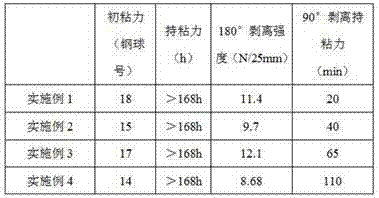Preparation method of acrylate pressure-sensitive adhesive emulsion with block structure
A pressure-sensitive adhesive emulsion and acrylate technology, which is applied in the field of pressure-sensitive adhesives, can solve problems such as water resistance, heat resistance, infiltration, poor coating, environmental pollution, and incomplete crosslinking, and achieve outstanding comprehensive performance and glass Low melting temperature and good surface resistance
- Summary
- Abstract
- Description
- Claims
- Application Information
AI Technical Summary
Problems solved by technology
Method used
Image
Examples
Embodiment 1
[0024] Step (1) Weigh 30 parts of deionized water, 0.3 parts of emulsifier SE-10, and 0.25 parts of emulsifier TX-4SA into the pre-emulsification kettle, start stirring, add 80 parts of butyl acrylate, 10 parts of isooctyl acrylate , stirred for 30 minutes to obtain the acrylate monomer pre-emulsion; weighed 6 parts of deionized water and 0.12 parts of emulsifier SE-10 and added them to another pre-emulsification kettle, started stirring, added 10 parts of styrene, and stirred for 30 minutes to obtain styrene monomer pre-emulsion;
[0025] Step (2) Add 40 parts of deionized water and 0.02 parts of AS-801 into the reaction kettle, raise the temperature to 65-70°C, turn on the condensation reflux device, stir and raise the temperature to 80°C,
[0026] Add 2.5% acrylate monomer pre-emulsion, then dissolve 0.12 parts of ammonium persulfate in 3 parts of water and add it to the reaction kettle at one time, and react for 30 minutes;
[0027] Step (3) Add 38% acrylate monomer pre-e...
Embodiment 2
[0029] Step (1) Weigh 30 parts of deionized water, 0.36 parts of DNS-86, and 0.24 parts of emulsifier SN-10 into the pre-emulsification kettle, start stirring, add 70 parts of butyl acrylate, 16 parts of
[0030] Isooctyl acrylate and 2 parts of methacrylic acid were stirred for 30 minutes to obtain an acrylate monomer pre-emulsion; weighed 6 parts of deionized water and 0.12 parts of emulsifier SE-10 into another pre-emulsification kettle, started stirring, and added 12 parts of styrene, stirred for 30min to obtain styrene monomer pre-emulsion;
[0031] Step (2) Add 36 parts of deionized water and 0.012 parts of emulsifier AES-4 into the reactor, raise the temperature to 65-70°C, turn on the condensation reflux device, stir and raise the temperature to 80°C, add 3.5% acrylate monomer pre-emulsion, Then dissolve 0.09 parts of ammonium persulfate in 3 parts of water and add it to the reaction kettle at one time, and react for 30 minutes;
[0032] Step (3) Add 26% acrylate mono...
Embodiment 3
[0035] Step (1) Weigh 30 parts of deionized water, 0.3 parts of emulsifier SE-10, and 0.45 parts of emulsifier AMPS into the pre-emulsification kettle, start stirring, add 70 parts of butyl acrylate, 18 parts of isooctyl acrylate, 2 1 part of hydroxyethyl methacrylate, 2 parts of glycidyl methacrylate, and stirred for 30 minutes to obtain an acrylate monomer pre-emulsion; weigh 6 parts of deionized water and 0.09 parts of emulsifier SE-10 and add it to another pre-emulsification tank , start stirring, add 8 parts of styrene, stir for 30min to obtain styrene monomer pre-emulsion;
[0036] Step (2) Add 45 parts of deionized water and 0.018 parts of NPES-4 to the reactor, raise the temperature to 65-70°C, turn on the condensation reflux device, stir and raise the temperature to 80°C, add 2.5% acrylate monomer pre-emulsion, and then Dissolve 0.12 parts of ammonium persulfate in 3 parts of water and add it to the reaction kettle at one time, and react for 30 minutes;
[0037] Step...
PUM
 Login to View More
Login to View More Abstract
Description
Claims
Application Information
 Login to View More
Login to View More - R&D
- Intellectual Property
- Life Sciences
- Materials
- Tech Scout
- Unparalleled Data Quality
- Higher Quality Content
- 60% Fewer Hallucinations
Browse by: Latest US Patents, China's latest patents, Technical Efficacy Thesaurus, Application Domain, Technology Topic, Popular Technical Reports.
© 2025 PatSnap. All rights reserved.Legal|Privacy policy|Modern Slavery Act Transparency Statement|Sitemap|About US| Contact US: help@patsnap.com

